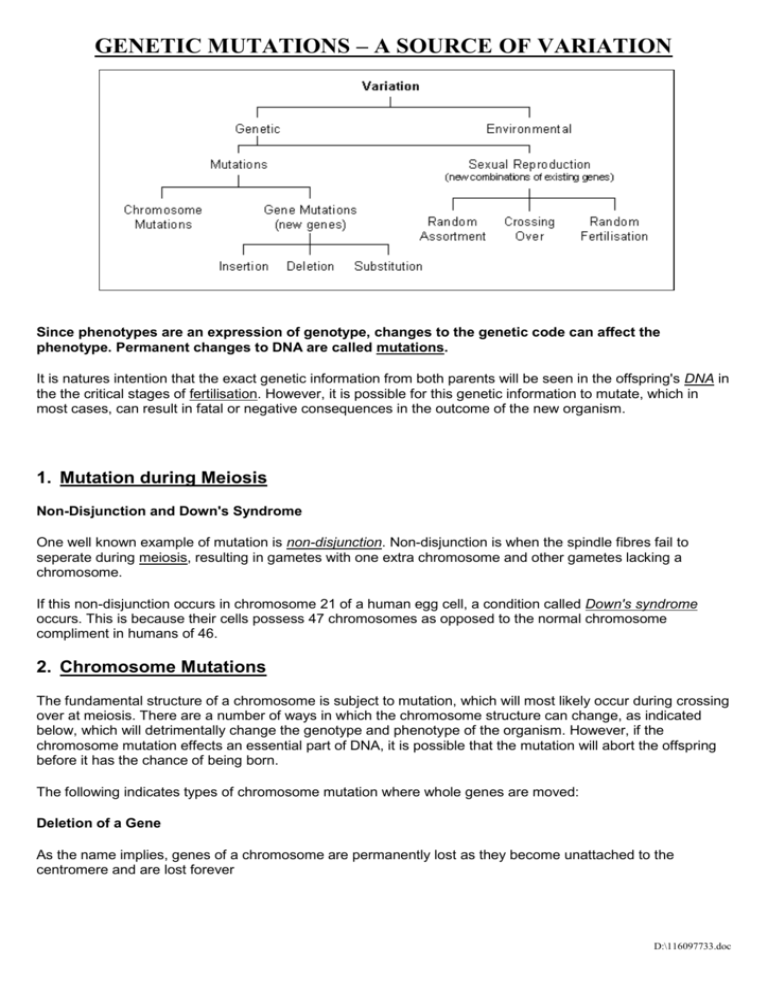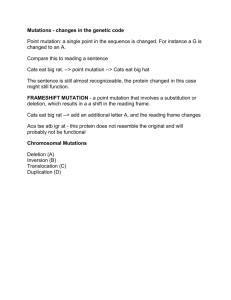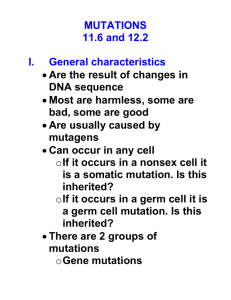Genetic Mutations IS (Answers for student cloze exercise)
advertisement

GENETIC MUTATIONS – A SOURCE OF VARIATION Since phenotypes are an expression of genotype, changes to the genetic code can affect the phenotype. Permanent changes to DNA are called mutations. It is natures intention that the exact genetic information from both parents will be seen in the offspring's DNA in the the critical stages of fertilisation. However, it is possible for this genetic information to mutate, which in most cases, can result in fatal or negative consequences in the outcome of the new organism. 1. Mutation during Meiosis Non-Disjunction and Down's Syndrome One well known example of mutation is non-disjunction. Non-disjunction is when the spindle fibres fail to seperate during meiosis, resulting in gametes with one extra chromosome and other gametes lacking a chromosome. If this non-disjunction occurs in chromosome 21 of a human egg cell, a condition called Down's syndrome occurs. This is because their cells possess 47 chromosomes as opposed to the normal chromosome compliment in humans of 46. 2. Chromosome Mutations The fundamental structure of a chromosome is subject to mutation, which will most likely occur during crossing over at meiosis. There are a number of ways in which the chromosome structure can change, as indicated below, which will detrimentally change the genotype and phenotype of the organism. However, if the chromosome mutation effects an essential part of DNA, it is possible that the mutation will abort the offspring before it has the chance of being born. The following indicates types of chromosome mutation where whole genes are moved: Deletion of a Gene As the name implies, genes of a chromosome are permanently lost as they become unattached to the centromere and are lost forever D:\116097733.doc Normal chromosome before mutation Genes not attached to centromere become loose and lost forever New chromosome lacks certain genes which may prove fatal depending on how important these genes are Duplication of Genes In this mutation, the mutants genes are displayed twice on the same chromosome due to duplication of these genes. This can prove to be an advantageous mutation as no genetic information is lost or altered and new genes are gained Normal chromosome before mutation Genes from the homologous chromosome are copied and inserted into the genetic sequence New chromosome possesses all its initial genes plus a duplicated one, which is usually harmless Inversion of Genes This is where the order of a particular order of genes are reversed as seen below Normal chromosome un-altered The connection between genes break and the sequence of these genes are reversed The new sequence may not be viable to produce an organism, depending on which genes are reversed. Advantageous characteristics from this mutation are also possible Translocation of Genes This is where information from one of two homologous chromosomes breaks and binds to the other. Usually this sort of mutation is lethal D:\116097733.doc An un-altered pair of homologous chromosomes Translocation of genes has resulted in some genes from one of the chromosomes attaching to the opposing chromosome 3. Point (Gene) Mutations - Alteration of a DNA Sequence The previous examples of mutation have investigated changes at the chromosome level. The sequence of nucleotides on a DNA sequence are also susceptible to mutation. Deletion Here, certain nucleotides are deleted, which affects the coding of proteins that use this DNA sequence. If for example, a gene coded for alanine, with a genetic sequence of C-G-G, and the cytosine nucleotide was deleted, then the alanine amino acid would not be able to be created, and any other amino acids that are supposed to be coded from this DNA sequence will also be unable to be produced because each successive nucleotide after the deleted nucleotide will be out of place. Insertion Similar to the effects of deletion, where a nucleotide is inserted into a genetic sequence and therefore alters the chain thereafter. This alteration of a nucleotide sequence is known as frameshift Inversion Where a particular nucleotide sequence is reversed, and is not as serious as the above mutations. This is because the nucleotides that have been reversed in order only affect a small portion of the sequence at large Substitution A certain nucleotide is replaced with another, which will affect any amino acid to be synthesised from this sequence due to this change. If the gene is essential, i.e. for the coding of haemoglobin then the effects are serious, and organisms in this instance suffer from a condition called sickle cell anaemia. All of the genetic mutations looked at through the last 2 pages more or less have a negative impact and are undesired, however, in some cases they can prove advantageous. Genetic mutations increase genetic diversity and therefore have an important part to play. They are also the reason many people inherit diseases. Next, we look at polyploidy, a type of mutation that effects chromosome content of an organism, and also investigates the frequency of mutations and factors that play a part in this. 4. Polyploidy Humans are diploid creatures, meaning for every chromosome in our body, there is another one to match it. Read the following Haploid creatures have one of each chromosome Diploid creatures have two of each chromosome Triploid creatures have three of each chromosome Polyploid creatures have three or more of each chromosome They can be represented by n where n equals haploid, 2n equals diploid and so on. D:\116097733.doc It is possible for a species, particularly plant species, to produce offspring that contains more chromosomes than its parent. This can be a result of non-disjunction, where normally a diploid parent would produce diploid offspring, but in the case of non-disjunction in one of the parents, produces a polyploid. In the case of triploids, although the creation of particular triploids in species is possible, they cannot reproduce themselves because of the inability to pair homologous chromosomes at meiosis, therefore preventing the formation of gametes. Polyploidy is responsible for the creation of thousands of species in today's planet, and will continue to do so. It is also responsible for increasing genetic diversity and producing species showing an increase in size, vigour and an increased resistance to disease. 5. Mutation Frequency This page and the previous two have investigated the different ways that mutations arise, and the following elaborates on the ways in which mutations are instigated. Barring all external factors, mutations occur very rarely, and are rarely expressed because many forms of mutation are expressed by a recessive allele. However there are many mutagenic agents that artificially increase the rate of mutations in an organism. The following are some factors that increase genetic mutations in organisms Members of species in a particular geographic area or ethnic origin are more susceptible to mutations High dosages of X-Rays or ultraviolet light can increase the likeliness of a mutation Radioactive substances increase the rate of mutations exponentially As mentioned previously, genetic mutations are a source of new variation in a species because it physically alters the sequence of nucleotides in a given sequence, therefore altering the genome in a unique way. The next pages investigate genetic diversity in more detail, an how certain alleles (perhaps mutations) are favoured over other alleles in natural selection... D:\116097733.doc









